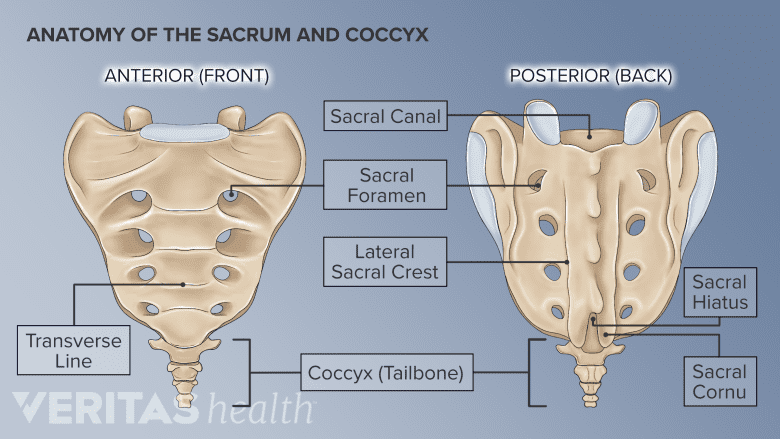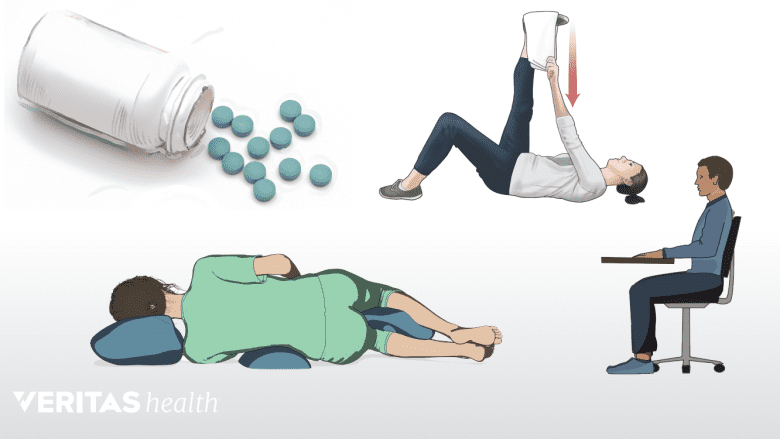Buttock muscle pain may originate within the gluteal space or in the lower back, pelvis, or hip. Pain in the buttock is usually associated with lower back and/or hip stiffness and makes daily activities hard to perform. Activities such as putting on shoes, sitting, standing up from a sitting position, walking, and/or driving are commonly affected.
Conditions that cause buttock pain may affect the nerves within the gluteal space, causing radiating symptoms to the hip, thigh, and/or leg–similar to sciatica. Buttock pain treatments typically include a combination of rest, self-care, and medical management.
This blog outlines the potential causes of buttock pain and effective treatments to relieve it.
Buttock pain that originates in the gluteal region
Buttock pain that originates in the gluteal region may be caused by conditions affecting the buttock muscles or problems in the bones and joints of the pelvis and hip. These conditions include:

Buttock pain may occur due to conditions affecting the superficial and deep muscles of the buttock, joints surrounding the buttock, and/or the pelvic nerves.
Myofascial pain syndrome. A common cause of buttock muscle pain is myofascial pain syndrome, which affects the large gluteus maximus and gluteus medius muscles of the buttock. Myofascial pain syndrome is characterized by the formation of painful muscle knots, called trigger points, which elicit sharp pain when pressed or touched gently. Pain from these trigger points can spread to the entire buttock area.
See Myofascial Release Therapy
Trigger points develop as a result of muscle fatigue from chronic trauma or repeated microtrauma to the buttock, such as from excessive physical activity.1Falótico GG, Torquato DF, Roim TC, Takata ET, de Castro Pochini A, Ejnisman B. Gluteal pain in athletes: how should it be investigated and treated?. Rev Bras Ortop. 2015;50(4):462-468. Published 2015 Jul 18. doi:10.1016/j.rboe.2015.07.002
Piriformis syndrome. Piriformis syndrome is a condition in which the piriformis muscle, located deep in the buttock, spasms and causes buttock pain. The piriformis muscle can also irritate the nearby sciatic nerve and cause pain, numbness, and tingling along the back of the thigh and leg—causing sciatica-like pain in the buttock.
The most common causes of piriformis syndrome are when the piriformis muscle spasms, becomes tight, or increases in volume or mass (muscle hypertrophy) as a result of trauma, overuse, or poor posture.2Hicks BL, Lam JC, Varacallo M. Piriformis Syndrome. [Updated 2022 Sep 4]. In: StatPearls [Internet]. Treasure Island (FL): StatPearls Publishing; 2022 Jan-. Available from: https://www.ncbi.nlm.nih.gov/books/NBK448172/#_NBK448172_pubdet_,3Grgić V. [Piriformis muscle syndrome: etiology, pathogenesis, clinical manifestations, diagnosis, differential diagnosis and therapy]. Lijec Vjesn. 2013;135(1-2):33-40. https://pubmed.ncbi.nlm.nih.gov/23607175/,4Babu A, Gupta A, Sharma P, Ranjan P, Kumar A. Blunt traumatic superior gluteal artery pseudoaneurysm presenting as gluteal hematoma without bony injury: A rare case report. Chin J Traumatol. 2016.19(4):244-246. http://doi.org/10.1016/j.cjtee.2015.11.018,5Roy BA. Piriformis Syndrome. ACSM’s Health & Fitness Journal. 2014.18(4):3-4 http://doi.org/10.1249/FIT.0000000000000055
Ischial bursitis. Ischial bursitis is the inflammation of the ischial bursa, a fluid-filled sac that provides cushioning between the hamstring muscles and the ischial tuberosity—the prominent part of the lower rim of the pelvic bone. The ischial tuberosities are also called sit bones because they contact the sitting surface and absorb the weight of the body while sitting. Buttock pain while seated for a long period is a classic symptom of ischial bursitis. Pressing the bony prominence of the lower pelvic rim also elicits pain.1Falótico GG, Torquato DF, Roim TC, Takata ET, de Castro Pochini A, Ejnisman B. Gluteal pain in athletes: how should it be investigated and treated?. Rev Bras Ortop. 2015;50(4):462-468. Published 2015 Jul 18. doi:10.1016/j.rboe.2015.07.002
Ischial bursitis occurs due to tendon injuries of the hamstrings.1Falótico GG, Torquato DF, Roim TC, Takata ET, de Castro Pochini A, Ejnisman B. Gluteal pain in athletes: how should it be investigated and treated?. Rev Bras Ortop. 2015;50(4):462-468. Published 2015 Jul 18. doi:10.1016/j.rboe.2015.07.002
- Ischiofemoral impingement. Ischiofemoral impingement occurs when there is abnormal contact between the outer rim of the pelvic bone (ischium) and the top of the thigh bone (femur). This type of contact can cause buttock pain and is more common in females.1Falótico GG, Torquato DF, Roim TC, Takata ET, de Castro Pochini A, Ejnisman B. Gluteal pain in athletes: how should it be investigated and treated?. Rev Bras Ortop. 2015;50(4):462-468. Published 2015 Jul 18. doi:10.1016/j.rboe.2015.07.002
Rarely, stress fractures of the ischiopubic ramus (the lower part of the pelvic bone) may cause buttock pain. Additional symptoms of a fractured ischiopubic ramus include worsening of symptoms in a standing position or while standing on one foot (on the affected side).1 If an ischiopubic ramus fracture is suspected, immediate medical evaluation and treatment by a specialist physician are warranted.
Buttock pain that originates in the pelvic area
The pelvic area consists of the pelvic floor, sacrum, and coccyx. Disorders affecting these structures include:

Buttock pain originating in the pelvic area is commonly attributed to disorders of the sacrum and coccyx.
- Coccydynia. The tailbone, located at the very bottom of the spine, is medically known as the coccyx. Coccydynia is a condition that causes moderate to severe pain in the coccyx and is typically felt as localized pain around the midline of the buttock. Coccydynia symptoms worsen while sitting, reclining, standing up from a seated position, or any activity that puts pressure on the bottom of the spine.6Mabrouk A, Alloush A, Foye P. Coccyx Pain. [Updated 2022 Sep 25]. In: StatPearls [Internet]. Treasure Island (FL): StatPearls Publishing; 2022 Jan-. Available from: https://www.ncbi.nlm.nih.gov/books/NBK563139/
- Pelvic floor dysfunction. The muscles of the pelvic floor help support vital organs and control motion in the hip, sacroiliac (SI) joint, lower back, and trunk. If these muscles become overactive without adequate periods of relaxation, they may cause pain in the buttock, lower abdomen, tailbone area (coccyx), and the back of the thigh. This condition is called pelvic floor dysfunction and is more common in cyclists and in women after pregnancy. Buttock and thigh pain due to pelvic floor dysfunction can mimic sciatica.1Falótico GG, Torquato DF, Roim TC, Takata ET, de Castro Pochini A, Ejnisman B. Gluteal pain in athletes: how should it be investigated and treated?. Rev Bras Ortop. 2015;50(4):462-468. Published 2015 Jul 18. doi:10.1016/j.rboe.2015.07.002,7Yuan X, Bevelaqua AC. Buttock pain in the athlete: the role of pelvic floor dysfunction. Curr Phys Med Rehabil Rep. 2018;6(2):147-155. doi:10.1007/s40141-018-0188-7
- Endometriosis. Endometriosis is a gynecological disorder that affects women exclusively. The condition causes the tissues of the uterus to grow outside the womb. The condition usually causes moderate to severe lower back pain, pelvic pain, and lower abdominal pain during menstruation.8Alimi Y, Iwanaga J, Loukas M, Tubbs RS. The Clinical Anatomy of Endometriosis: A Review. Cureus. 2018;10(9):e3361. Published 2018 Sep 25. doi:10.7759/cureus.3361 Some women may also experience hip and buttock pain during endometriosis if the sciatic nerve is involved.9Saar TD, Pacquée S, Conrad DH, et al. Endometriosis Involving the Sciatic Nerve: A Case Report of Isolated Endometriosis of the Sciatic Nerve and Review of the Literature. Gynecol Minim Invasive Ther. 2018;7(2):81-85. doi:10.4103/GMIT.GMIT_24_18
Rarely, tumors or severe nerve disorders in the sacral and coccygeal spine may cause buttock pain in addition to severe lower back or leg pain, severe numbness and weakness in the buttock/thigh area, night pain, progressive weight loss, and/or loss of appetite. These symptoms indicate a medical emergency and must be evaluated by a physician immediately.
Sciatica pain in the buttock

Sciatica pain may sometimes be referred to the buttock, and piriformis syndrome can mimic sciatica pain in the buttock area.
Sciatica is a set of symptoms that originate in the lower back when the spinal nerves are inflamed, irritated, pinched, or compressed. Sciatica symptoms include mild to severe pain, numbness, altered sensation, and weakness in the lower back, thigh, leg, and foot on one side. Sciatica pain in the buttock can occur in conditions such as pulled muscle injury in the lower back, sacroiliac joint dysfunction, and compression of the spinal nerves at L4-L5 and L5-S1 spinal segments.1Falótico GG, Torquato DF, Roim TC, Takata ET, de Castro Pochini A, Ejnisman B. Gluteal pain in athletes: how should it be investigated and treated?. Rev Bras Ortop. 2015;50(4):462-468. Published 2015 Jul 18. doi:10.1016/j.rboe.2015.07.002
Sciatica-like pain may occur in the buttock due to piriformis syndrome, where an inflamed or spasming piriformis muscle presses on the sciatic nerve, causing symptoms similar to sciatica.
How to relieve buttock muscle pain

A variety of treatments can help relieve buttock muscle pain.
Buttock muscle pain may be treated with over-the-counter (OTC) medications, heat and/or cold therapy, and gentle stretching exercises that target the buttock, hip, and lower back muscles. Using a foam roller or tennis ball to gently massage the gluteal region can help release trigger point pain in the superficial and deep gluteal muscles and relieve buttock pain.
Lifestyle modifications include using a supported posture while sitting and avoiding sitting on hard or uneven surfaces, which help reduce stress on the buttock and pelvic structures. If these self-care methods do not help reduce buttock pain in a few days or weeks or if the pain progressively worsens, a medical evaluation is warranted.
The specific treatment for buttock muscle pain depends on the underlying condition that’s causing it—which can be accurately diagnosed by a physician who specializes in musculoskeletal disorders of the spine. Unless a medical emergency, such as cauda equina syndrome or spinal tumor is diagnosed, nonsurgical treatments are typically tried first before more invasive treatments like injections and surgery are considered.
Watch Got Buttock Pain? Discover What’s Causing It and How to Fix It Video
Learn more:
2 Essential Stretches to Relieve Piriformis Syndrome Symptoms
- 1 Falótico GG, Torquato DF, Roim TC, Takata ET, de Castro Pochini A, Ejnisman B. Gluteal pain in athletes: how should it be investigated and treated?. Rev Bras Ortop. 2015;50(4):462-468. Published 2015 Jul 18. doi:10.1016/j.rboe.2015.07.002
- 2 Hicks BL, Lam JC, Varacallo M. Piriformis Syndrome. [Updated 2022 Sep 4]. In: StatPearls [Internet]. Treasure Island (FL): StatPearls Publishing; 2022 Jan-. Available from: https://www.ncbi.nlm.nih.gov/books/NBK448172/#_NBK448172_pubdet_
- 3 Grgić V. [Piriformis muscle syndrome: etiology, pathogenesis, clinical manifestations, diagnosis, differential diagnosis and therapy]. Lijec Vjesn. 2013;135(1-2):33-40. https://pubmed.ncbi.nlm.nih.gov/23607175/
- 4 Babu A, Gupta A, Sharma P, Ranjan P, Kumar A. Blunt traumatic superior gluteal artery pseudoaneurysm presenting as gluteal hematoma without bony injury: A rare case report. Chin J Traumatol. 2016.19(4):244-246. http://doi.org/10.1016/j.cjtee.2015.11.018
- 5 Roy BA. Piriformis Syndrome. ACSM’s Health & Fitness Journal. 2014.18(4):3-4 http://doi.org/10.1249/FIT.0000000000000055
- 6 Mabrouk A, Alloush A, Foye P. Coccyx Pain. [Updated 2022 Sep 25]. In: StatPearls [Internet]. Treasure Island (FL): StatPearls Publishing; 2022 Jan-. Available from: https://www.ncbi.nlm.nih.gov/books/NBK563139/
- 7 Yuan X, Bevelaqua AC. Buttock pain in the athlete: the role of pelvic floor dysfunction. Curr Phys Med Rehabil Rep. 2018;6(2):147-155. doi:10.1007/s40141-018-0188-7
- 8 Alimi Y, Iwanaga J, Loukas M, Tubbs RS. The Clinical Anatomy of Endometriosis: A Review. Cureus. 2018;10(9):e3361. Published 2018 Sep 25. doi:10.7759/cureus.3361
- 9 Saar TD, Pacquée S, Conrad DH, et al. Endometriosis Involving the Sciatic Nerve: A Case Report of Isolated Endometriosis of the Sciatic Nerve and Review of the Literature. Gynecol Minim Invasive Ther. 2018;7(2):81-85. doi:10.4103/GMIT.GMIT_24_18

